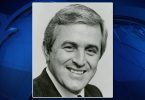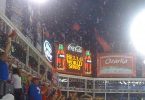Somewhere along the way of human history someone sometime, compelled by inspiration unknown, coined a phrase that stuck with romanticists.
“March winds and April showers bring May flowers.”
In reality, it’s more like weeds and June bugs. Don’t forget those.
But in addition to all the undesirables, the first week of May has also been a time of bloom in baseball feats that have stuck.
On Wednesday, we celebrated the 28th anniversary of Nolan Ryan’s unprecedented seventh no-hitter.
There was no historical precedent for what had happened that day. No one even in baseball’s holy place of history in Cooperstown, N.Y., had done what the Ryan Express achieved that evening in Arlington in 1991.
Ryan had already tossed the most no-no’s in history and, at 44, he was already the oldest to throw one, too. His first occurred on May 15 in 1973.
Ryan struck out 16 Toronto hitters in a 3-0 victory, including Roberto Alomar for the final out.
“I never think about what my place in baseball history will be,” Ryan, always an exemplar of humility, said afterward. “The Hall of Fame never crosses my mind.”
Ryan’s seventh no-hitter was one record set the first week of May that will never be touched, especially if the doomsayers are right and we only have 12 years left as the melted ice from the Titanic’s titanic nemesis takes us all back underwater, as we were before thousands of years ago.
Just speaking for myself, but I’m not a strong swimmer. So, smoke ’em if you got ’em, like strong swimmer Michael Phelps.
But, no, active pitchers with two include one-time TCU ace Jake Arrieta, Max Scherzer, Justin Verlander and Homer Bailey.
It’s just not happening.
On the same day that Ryan dazzled the more than 33,000 Rangers partisans, Rickey Henderson swiped career stolen base No. 939, eclipsing Lou Brock’s 938.
“I am the greatest of all time,” said Rickey, believing every word and reveling in every syllable.
The baseball gods intervened that day, make no mistake, in Ryan stealing Henderson’s limelight.
However, no one will reach Henderson’s 1,406 career stolen bases.
That’s because the smartest guys in the room declared from their computer consoles that stolen bases is dumb baseball strategy in the era of exit velocity. The game is less about .300 hitters and on-base guys and trending – for several years now – in the direction of three-run homers and strikeout after strikeout after strikeout.
That triggers in guys like me a gag reflex and a pain in the backside, but it’s the day of the brainiacs, and they have calculated the risk-reward of the stolen base. The result: Steal attempts have been relegated by these accountants to the category of “giving outs away.”
To darkest reaches of the closet you go, steal attempts.
Rickey, your record is safe, and one day soon will be added to a museum exhibit displaying artifacts of prehistoric life.
The active leader in steals is Dee Gordon, who hasn’t stolen 316 bases in any flash. In 2018, major leaguers stole 2,474 bases, the fewest in a full season since 1973, when teams combined for 2,034 steals in a 24-team league.
On April 29 of 1986, Roger Clemens struck out 20 Seattle hitters, besting the record of 19 set most recently by Ryan in 1974.
This one is gettable, especially considering how they play the game today. Nominees for golden sombreros grow by the season in this new game of ours.
It’s not like it hasn’t been coming on. Reggie Jackson became the first major leaguer to strike out 2,000 times in his career on May 13, 1983. Four of the next five — Andres Galarraga is the exception — in career strikeouts all began their careers after Jackson, who retired in 1987, and all have more than 2,000 K’s.
In fact, the 20-strikeout mark has been matched four times, including by Clemens again 10 years later – by then, according to George Mitchell, he had discovered the secret sauce, and I’m not talking about Gaylord Perry’s secret sauce. Kerry Wood struck out 20 in a game in 1998 — in his fifth career start, on May 6 — Randy Johnson did it in 2001 and Max Scherzer did it most recently in 2016.
The intentional walk and the shutout had days in May.
It’s difficult to imagine someone eclipsing the five intentional walks issued Andre Dawson in 1990. Dawson was walked intentionally five times in eight plate appearances by the Reds in a 16-inning game.
On the second day of the month, 1923, Walter Johnson and his overpowering fastball hurled his 100th career shutout. Barney held the Yankees to three hits in winning 3-0. Babe Ruth was 0 for 2 with two walks and a strikeout. Wally Pipp was 0 for 4.
The active leader in shutouts is Clayton Kershaw, who, at 31, has 15. By the time Johnson was 31, he had 86.
It was a different day.
Grover Cleveland Alexander is next on the list with 90, followed by Christy Mathewson, Cy Young, Eddie Plank and Warren Spahn. Tom Seaver and Nolan Ryan are next at 61. Bert Blyleven and Don Sutton follow.
Injury and a changed philosophy, in terms of pitcher’s use, the reliever and the Players Association, have ensured Johnson’s 110 complete games are in cement.
Johnson was also one of first of our notable sports celebrities to turn to politics after his playing days.
In that endeavor, he struck out.
“He was an utterly inexperienced speaker,” said Joe Martin, the future speaker of the house. “I got some of my boys to write two master speeches for him – one for the farmers of his district and the other for the industrial areas. Alas, he got the two confused. He addressed the farmers on industrial problems, and the businessmen on farm problems.”
On the subject of droning on, there was May 1, 1920, the longest game by innings in history.
The Brooklyn Robins and Boston Braves finished tied 1-1 in 26 innings. Both starting pitchers, Brooklyn’s Leon Cadore and Boston’s Joe Oeschger, went all 26.
Can you imagine today’s attention deficit disordered sitting around for 26 innings? And the game ended in a tie!
There would be screaming memes on Twitter.
On May 2, 1941, Ted Williams ended the day hitting .308, the low point of his .400 season. We’ll never see another of those. On the same day in 1954, Stan Musial hit five home runs in a doubleheader, a record he shares today with Nate Colbert, who hit five in a 1972 double-dip.
That same year, on May 15, Joe DiMaggio had a hit and an RBI in the Yankees’ 13-1 victory, but that was the start of 56 consecutive games with a hit.
One who chased DiMaggio at one point was Pete Rose, who is a man with a record, in every sense of the word.
On May 2, 1988, Bart Giamatti, then the NL president, handed down a 30-day suspension to Rose for pushing umpire Dave Pallone during an on-field dispute over a call at first base. The safe call allowed the eventual winning run to score in the Mets’ 6-5 victory.
May never was the hit king’s best month. Rose hit a career-low .283 during the month over his 24-year career in which he had a .303 average.
Rose called the punishment “excessive.”
Ho-ho-ho. If he only knew.
Rose returned, but he wasn’t sticking around for long. We would find out a year later why Pete was so emphatic about that call.







